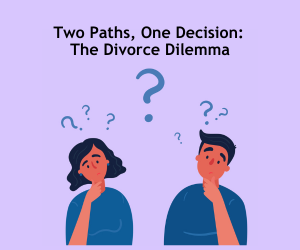 Part 2: Having lawyers that are fully committed to settlement creates better outcomes.
A Collaborative Divorce is one in which the husband and the wife each retain a lawyer for settlement purposes only.
Hiring a lawyer for this defined purpose has some risk. The success of Collaborative Divorce is based on the fact that, in most cases, the benefits far outweigh the risks. In order to understand why this is true, let’s look at the basic risks and benefits.
Risk: At the beginning of the case, both parties and their lawyers sign a Collaborative Commitment stating that the lawyers must withdraw if either spouse decides to fight in court. Therefore, the Collaborative Commitment creates a risk that you will need to switch attorneys during the divorce process. Indeed, that is the very idea behind the commitment.
How significant is the risk? In my experience of around 500 Collaborative Cases, the parties have had to switch attorneys approximately 5% of the time. By comparison, in my experience practicing in the traditional model (cases where the lawyers can go to court), the parties switched attorneys, or the attorneys withdrew from representation for other reasons, almost 5% of the time. So, in reality, the risk that clients need to switch attorneys by starting in the Collaborative Process may not be significantly greater than in a non-Collaborative case.
Benefits: The most significant benefit from the Collaborative Commitment is that the attorneys are free to focus all of their attention on more creative settlements. Removing, or at least significantly diminishing, the threat of court, opens the door to interest-based negotiation. Instead of using argument, accusation and threats of court, which are taken off the table, the attorneys advocate for their clients by using creativity, empathy and the development of shared goals.
What clients seem to want, in almost all instances, is a form of advocacy (meaning protection of true interests), without creating animosity. In traditional practice, I sometimes felt like a bull in a china shop, unable to go in and help my client get what he or she truly needed, without risking damage to fragile, but important, things like the ability to co-parent and communicate effectively. Collaborative Divorce, by removing court as an immediate threat, allows me work to help my clients with far less risk to the relationship and other intangible goals.
Of course, the success of Collaborative Divorce can depend on more than just the Collaborative Commitment. Specifically, the best outcomes in Collaborative Divorce are achieved with a) a high level of commitment by the clients and 2) the skill of the professionals. The keys to success in those areas will be discussed in the next two blogs in this series. For immediate information in these areas go to www.collaborativelaw.org or www.divorcechoice.com.
Check out Part 3 of this series, here.
Part 2: Having lawyers that are fully committed to settlement creates better outcomes.
A Collaborative Divorce is one in which the husband and the wife each retain a lawyer for settlement purposes only.
Hiring a lawyer for this defined purpose has some risk. The success of Collaborative Divorce is based on the fact that, in most cases, the benefits far outweigh the risks. In order to understand why this is true, let’s look at the basic risks and benefits.
Risk: At the beginning of the case, both parties and their lawyers sign a Collaborative Commitment stating that the lawyers must withdraw if either spouse decides to fight in court. Therefore, the Collaborative Commitment creates a risk that you will need to switch attorneys during the divorce process. Indeed, that is the very idea behind the commitment.
How significant is the risk? In my experience of around 500 Collaborative Cases, the parties have had to switch attorneys approximately 5% of the time. By comparison, in my experience practicing in the traditional model (cases where the lawyers can go to court), the parties switched attorneys, or the attorneys withdrew from representation for other reasons, almost 5% of the time. So, in reality, the risk that clients need to switch attorneys by starting in the Collaborative Process may not be significantly greater than in a non-Collaborative case.
Benefits: The most significant benefit from the Collaborative Commitment is that the attorneys are free to focus all of their attention on more creative settlements. Removing, or at least significantly diminishing, the threat of court, opens the door to interest-based negotiation. Instead of using argument, accusation and threats of court, which are taken off the table, the attorneys advocate for their clients by using creativity, empathy and the development of shared goals.
What clients seem to want, in almost all instances, is a form of advocacy (meaning protection of true interests), without creating animosity. In traditional practice, I sometimes felt like a bull in a china shop, unable to go in and help my client get what he or she truly needed, without risking damage to fragile, but important, things like the ability to co-parent and communicate effectively. Collaborative Divorce, by removing court as an immediate threat, allows me work to help my clients with far less risk to the relationship and other intangible goals.
Of course, the success of Collaborative Divorce can depend on more than just the Collaborative Commitment. Specifically, the best outcomes in Collaborative Divorce are achieved with a) a high level of commitment by the clients and 2) the skill of the professionals. The keys to success in those areas will be discussed in the next two blogs in this series. For immediate information in these areas go to www.collaborativelaw.org or www.divorcechoice.com.
Check out Part 3 of this series, here.
Two Paths, One Decision: The Divorce Dilemma
Emily and Daniel were in love. Their love story had once been the envy of the neighborhood—a whirlwind romance that blossomed into a marriage filled with laughter, shared dreams, and whispered secrets. But as the years went by, cracks appeared in their fairy tale....



